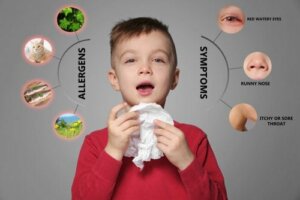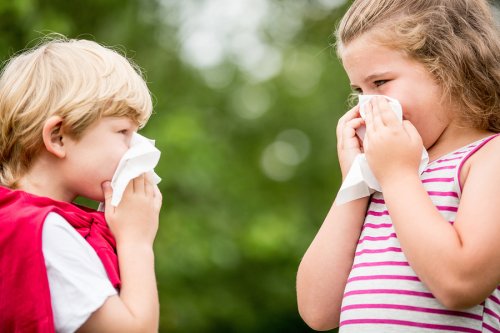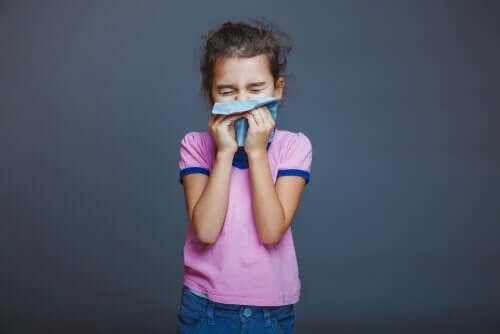Preventing Allergies in Children: What Does the Evidence Say?

Allergies are becoming more and more common. What’s more, given the seriousness of contact with any allergen, they’ve become a public health problem. For this reason, recent research aims to discover their origin and how to prevent allergies in children.
That’s because childhood is the most vulnerable stage to these reactions. Before looking at the research, we’ll start by explaining the basics.
Allergies in children
An allergy is an immune system reaction mediated by antibodies, cells or immune complexes. It’s triggered by proteins in food, dust, pollen and animals (i.e. cat hair), among other factors. In addition, it can occur as a result of contact, ingestion or inhalation. Therefore, there’s a great variety of symptoms.
These symptoms range from nausea, vomiting and diarrhea to skin rashes and itching or difficulty breathing. Therefore, it’s very important to act as quickly as possible and always have adrenaline on hand to avoid serious consequences.
Based on all of the above, it’s clear that allergies in children negatively affect their social life, at least in the beginning. So, psychological help and a dietitian or nutritionist are key to help you manage it.
Finally, treatment involves eliminating the triggering food and products that contain it as well as the use of antihistamines. Adrenaline is also important, but only in cases of reaction due to accidental consumption, ingestion or contact.

What factors predispose children to allergies?
This type of reaction always has a genetic component. That’s to say, the fact that a direct relative (mother, father or sibling) has allergies means a 30% greater chance of developing them. In fact, the chances can reach 70% if allergies already affect two or more family members.
Other triggers are:
- Constant hygiene. Although constant hygiene is good in the prevention of infectious diseases, the opposite occurs with allergies. The fact is that, at birth, a child’s defenses are developing. Therefore, it’s necessary to have initial contact with allergens. In this way, on subsequent occasions, the body will display rejection if it doesn’t tolerate a given allergen.
- C-section, which prevents the transmission of bacteria from the mother to the baby. As a result, the diversity of the child’s microbiota is less.
- The environment and pollution. This is why it’s more common for people to experience allergies in the spring, even when it hardly rains and the climate’s very dry. At the same time, the prevalence of allergies is higher in cities or areas close to factories.
- Stress.
- Bad eating habits. Consequently, there’s a deficit of essential nutrients such as vitamin A and D, which alters the intestinal microbial diversity.
In summary, the interaction between all triggers increases the risk of allergies in children.
Allergy, exercise and anti-inflammatories
Next, I would like to comment that there’s a relationship between a greater intensity of symptoms and the taking of anti-inflammatory drugs, such as ibuprofen, and the subsequent practice of exercise.
However, it’s necessary to combine the allergen with one of the other two factors, since the reaction wouldn’t manifest itself otherwise.
This is most common in children with asthma and atopic dermatitis, since the risk is higher. It manifests itself 2 to 4 hours after eating allergens like wheat, milk, fruit, fish, seafood or celery.
How to prevent allergies in children
Pregnancy and lactation, the beginning of preventing allergies in children
We’ve known for years that vaginal delivery and breastfeeding reduce the risk of allergies. They confer protection through the mother’s bacteria and immunoglobulins that reach the child through the flow and milk, respectively.
In addition, while the child remains in the mother’s womb, the mother’s defenses offer protection.
What if we change our habits?
As we’ve mentioned before, lifestyle is fundamental in the prevention of any disease related to the immune system. With regard to diet, brightly colored vegetables, fruits and leafy greens provide the necessary antioxidants to fight infections or external aggressions.
In addition, they’re an excellent source of vitamin A, which stimulates the production of IgAs. These antibodies facilitate the tolerance to food, as well as vitamin D. Vitamin D is found in oily fish (tuna, sardines, salmon, etc.), eggs, and dairy products, as well as in sun exposure. In addition, they activate immune cells and maintain the integrity of the intestinal barrier.

Even fiber is an essential nutrient for generating short-chain fatty acids that reduce inflammation. Other fiber-rich foods rich that are beneficial to microbes are whole grains (rice, oatmeal), tubers (potatoes and sweet potatoes), bananas and cooked apples, and some vegetables such as fennel, parsnips, asparagus, artichokes, leeks and onions.
The microbiota, the target organ to prevent allergy in children
The most recent research points to the microbiota to help reduce symptoms. We’re talking about a group of living microorganisms that regulate the permeability of the intestinal wall. They’re responsible for preventing the passage of harmful substances that hinder the functioning of the body. For this reason, having a great diversity in the quality and quantity of bacteria reduces the risk of allergies.
So far, we know that allergic children have lower levels of bacteroids, bifidobacteria, and enterococci. And, at the same time, they have increased levels of clostridia. For this reason, clinical studies have been conducted on the administration of probiotics. However, it’s too early to say which species, dose and duration are most recommended.
Conclusion
In conclusion, these are some of the aspects to take into account in order to avoid allergies in children. So, be on alert; oral immunotherapy is giving very good results, although there is still much to discover.
Allergies are becoming more and more common. What’s more, given the seriousness of contact with any allergen, they’ve become a public health problem. For this reason, recent research aims to discover their origin and how to prevent allergies in children.
That’s because childhood is the most vulnerable stage to these reactions. Before looking at the research, we’ll start by explaining the basics.
Allergies in children
An allergy is an immune system reaction mediated by antibodies, cells or immune complexes. It’s triggered by proteins in food, dust, pollen and animals (i.e. cat hair), among other factors. In addition, it can occur as a result of contact, ingestion or inhalation. Therefore, there’s a great variety of symptoms.
These symptoms range from nausea, vomiting and diarrhea to skin rashes and itching or difficulty breathing. Therefore, it’s very important to act as quickly as possible and always have adrenaline on hand to avoid serious consequences.
Based on all of the above, it’s clear that allergies in children negatively affect their social life, at least in the beginning. So, psychological help and a dietitian or nutritionist are key to help you manage it.
Finally, treatment involves eliminating the triggering food and products that contain it as well as the use of antihistamines. Adrenaline is also important, but only in cases of reaction due to accidental consumption, ingestion or contact.

What factors predispose children to allergies?
This type of reaction always has a genetic component. That’s to say, the fact that a direct relative (mother, father or sibling) has allergies means a 30% greater chance of developing them. In fact, the chances can reach 70% if allergies already affect two or more family members.
Other triggers are:
- Constant hygiene. Although constant hygiene is good in the prevention of infectious diseases, the opposite occurs with allergies. The fact is that, at birth, a child’s defenses are developing. Therefore, it’s necessary to have initial contact with allergens. In this way, on subsequent occasions, the body will display rejection if it doesn’t tolerate a given allergen.
- C-section, which prevents the transmission of bacteria from the mother to the baby. As a result, the diversity of the child’s microbiota is less.
- The environment and pollution. This is why it’s more common for people to experience allergies in the spring, even when it hardly rains and the climate’s very dry. At the same time, the prevalence of allergies is higher in cities or areas close to factories.
- Stress.
- Bad eating habits. Consequently, there’s a deficit of essential nutrients such as vitamin A and D, which alters the intestinal microbial diversity.
In summary, the interaction between all triggers increases the risk of allergies in children.
Allergy, exercise and anti-inflammatories
Next, I would like to comment that there’s a relationship between a greater intensity of symptoms and the taking of anti-inflammatory drugs, such as ibuprofen, and the subsequent practice of exercise.
However, it’s necessary to combine the allergen with one of the other two factors, since the reaction wouldn’t manifest itself otherwise.
This is most common in children with asthma and atopic dermatitis, since the risk is higher. It manifests itself 2 to 4 hours after eating allergens like wheat, milk, fruit, fish, seafood or celery.
How to prevent allergies in children
Pregnancy and lactation, the beginning of preventing allergies in children
We’ve known for years that vaginal delivery and breastfeeding reduce the risk of allergies. They confer protection through the mother’s bacteria and immunoglobulins that reach the child through the flow and milk, respectively.
In addition, while the child remains in the mother’s womb, the mother’s defenses offer protection.
What if we change our habits?
As we’ve mentioned before, lifestyle is fundamental in the prevention of any disease related to the immune system. With regard to diet, brightly colored vegetables, fruits and leafy greens provide the necessary antioxidants to fight infections or external aggressions.
In addition, they’re an excellent source of vitamin A, which stimulates the production of IgAs. These antibodies facilitate the tolerance to food, as well as vitamin D. Vitamin D is found in oily fish (tuna, sardines, salmon, etc.), eggs, and dairy products, as well as in sun exposure. In addition, they activate immune cells and maintain the integrity of the intestinal barrier.

Even fiber is an essential nutrient for generating short-chain fatty acids that reduce inflammation. Other fiber-rich foods rich that are beneficial to microbes are whole grains (rice, oatmeal), tubers (potatoes and sweet potatoes), bananas and cooked apples, and some vegetables such as fennel, parsnips, asparagus, artichokes, leeks and onions.
The microbiota, the target organ to prevent allergy in children
The most recent research points to the microbiota to help reduce symptoms. We’re talking about a group of living microorganisms that regulate the permeability of the intestinal wall. They’re responsible for preventing the passage of harmful substances that hinder the functioning of the body. For this reason, having a great diversity in the quality and quantity of bacteria reduces the risk of allergies.
So far, we know that allergic children have lower levels of bacteroids, bifidobacteria, and enterococci. And, at the same time, they have increased levels of clostridia. For this reason, clinical studies have been conducted on the administration of probiotics. However, it’s too early to say which species, dose and duration are most recommended.
Conclusion
In conclusion, these are some of the aspects to take into account in order to avoid allergies in children. So, be on alert; oral immunotherapy is giving very good results, although there is still much to discover.
All cited sources were thoroughly reviewed by our team to ensure their quality, reliability, currency, and validity. The bibliography of this article was considered reliable and of academic or scientific accuracy.
- Alvárez, G. El misterioso auge de las alergias alimentarias. El país. 3 octubre de 2018.
- Abc.es La dieta prenatal, el modo de parto y la alimentación infantil se relacionan con alergias infantiles. ABC 8 de noviembre de 2019.
- Aitoro, R.; Paparo,L.; Amoroso,A.; Di Costanzo, M.; Cosenza, L. et al. (2017). Gut microbiota as a target for preventive and therapeutic intervention against food allergy. Nutrients, 9(7), 972.
- Gigante, G.; Tortora, A.; Ianiro, G.; Ojetti,V.; Purchiarioni,F. et al. (2011). Role of gut microbiota in food tolerance and allergies. Digestive Diseases, 29(6), 540-549.
- Molloy, J.; Allen,K.; Collier, F.; Tang,M. ; Ward,A. et al. (2013). The potential link between gut microbiota and IgE-mediated food allergy in early life. International Journal of Environmental Research and Public Health, 10(12), 7235-7256.
- Canani, R.; Gilbert,J. A. y Nagler, C.R. (2015). The role of the commensal microbiota in the regulation of tolerance to dietary allergens. Current Opinion in Allergy and Clinical Inmunology, 15(3), 243-249.
This text is provided for informational purposes only and does not replace consultation with a professional. If in doubt, consult your specialist.








